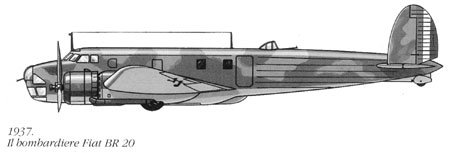An iconic Italian bomber of the late 1930s and early 40s, the Fiat Br 20 Cicogna was created not only as a military instrument but also as an instrument of propaganda for Benito Mussolini’s fascist regime. The Br 20 bomber was meant to be symbolic of fascist rearmament.
After the 1935 invasion of Ethiopia by Italian forces, it was decided that a new, modern bomber was required. In 1936, Celestino Rosatelli designed what was considered one of the most advanced bombers of its time (or so it appeared). The Fiat Br 20 Cicogna was a low-wing, twin-engine monoplane with all-metal framework, twin rudders and retractable landing gear. The Br 20 was also almost entirely stress-skinned except for a cloth covered section of the aft fuselage.
When the Fiat Br 20 Cicogna – or Stork – became operational a few were tested in the skies over the Spanish Civil War. It was a proficient enough aircraft for that conflict but had many flaws that needed to be sorted out in later versions. Japan purchased 100 of these first-run Br 20s and their deficiencies were further confirmed in the Chinese theatre. The Japanese phased them out as soon as the Mitsubishi K 21 became available.
A newer version, the Br 20M (Modificato), with heavier defensive guns and broader wings was developed before Italy entered World War II in June of 1940. Despite its celebrity the Br 20M performed poorly. Two squadrons travelled to Belgium to join in the Battle of Britain but faced heavy losses against the RAF. They were withdrawn within a few weeks.
The Cicogna went on to fight in Greece, Yugoslavia, Malta and North Africa but only did well when not facing opposition.
By 1943 only a few of the 602 ever built were still in service.
| Type | Medium Bomber |
| Power Plant | 2 x 1000-horsepower Fiat A80 radial engines |
| Max speed: | 425 km/h (264 mph) |
| Ceiling: | 6,750 m (22,145 ft.) |
| Range: | 2,752 km ( 1,710 mi.) |
| Weight (empty): | 6,700 kg ( 14,770 lb.) |
| Weight (loaded): | 10,000 kg ( 22,046 lb.) |
| Wingspan: | 21.56 m ( 70 ft. 9 in.) |
| Length: | 16.04 m ( 52 ft. 9 in.) |
| Height: | 4.75 m (15 ft. 7 in.) |
| Armament: | 4 x 7.7mm machine guns; up to 3,527 pounds of bombs |
| Service | 1936 – 1943 |
